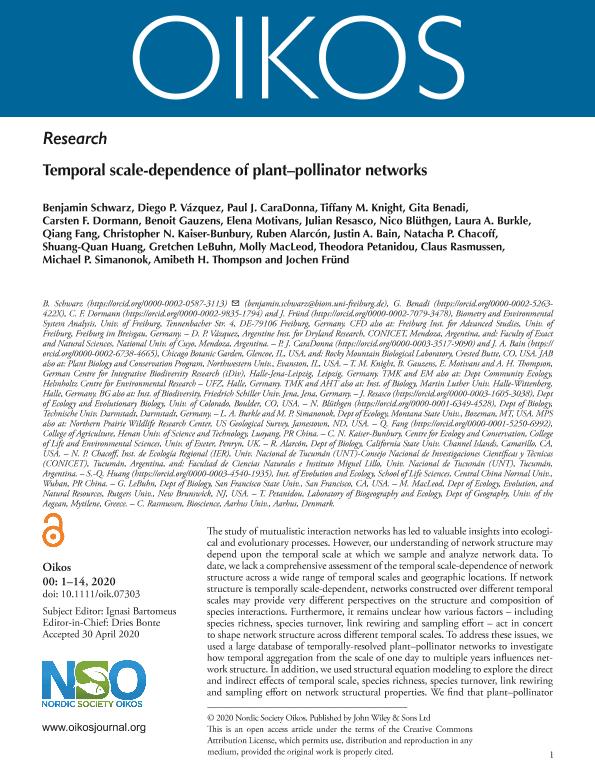Artículo
Temporal scale‐dependence of plant–pollinator networks
Schwarz, Benjamin; Vazquez, Diego P. ; Cara Donna, Paul J.; Knight, Tiffany M.; Benadi, Gita; Dormann, Carsten F.; Gauzens, Benoit; Motivans, Elena; Resasco, Julian; Blüthgen, Nico; Burkle, Laura A.; Fang, Qiang; Kaiser Bunbury, Christopher N.; Alarcón, Ruben; Bain, Justin A.; Chacoff, Natacha Paola
; Cara Donna, Paul J.; Knight, Tiffany M.; Benadi, Gita; Dormann, Carsten F.; Gauzens, Benoit; Motivans, Elena; Resasco, Julian; Blüthgen, Nico; Burkle, Laura A.; Fang, Qiang; Kaiser Bunbury, Christopher N.; Alarcón, Ruben; Bain, Justin A.; Chacoff, Natacha Paola ; Huang, Shuang Quan; LeBuhn, Gretchen; MacLeod, Molly; Petanidou, Theodora; Rasmussen, Claus; Simanonok, Michael P.; Thompson, Amibeth H.; Fründ, Jochen
; Huang, Shuang Quan; LeBuhn, Gretchen; MacLeod, Molly; Petanidou, Theodora; Rasmussen, Claus; Simanonok, Michael P.; Thompson, Amibeth H.; Fründ, Jochen
 ; Cara Donna, Paul J.; Knight, Tiffany M.; Benadi, Gita; Dormann, Carsten F.; Gauzens, Benoit; Motivans, Elena; Resasco, Julian; Blüthgen, Nico; Burkle, Laura A.; Fang, Qiang; Kaiser Bunbury, Christopher N.; Alarcón, Ruben; Bain, Justin A.; Chacoff, Natacha Paola
; Cara Donna, Paul J.; Knight, Tiffany M.; Benadi, Gita; Dormann, Carsten F.; Gauzens, Benoit; Motivans, Elena; Resasco, Julian; Blüthgen, Nico; Burkle, Laura A.; Fang, Qiang; Kaiser Bunbury, Christopher N.; Alarcón, Ruben; Bain, Justin A.; Chacoff, Natacha Paola ; Huang, Shuang Quan; LeBuhn, Gretchen; MacLeod, Molly; Petanidou, Theodora; Rasmussen, Claus; Simanonok, Michael P.; Thompson, Amibeth H.; Fründ, Jochen
; Huang, Shuang Quan; LeBuhn, Gretchen; MacLeod, Molly; Petanidou, Theodora; Rasmussen, Claus; Simanonok, Michael P.; Thompson, Amibeth H.; Fründ, Jochen
Fecha de publicación:
05/2020
Editorial:
Wiley Blackwell Publishing, Inc
Revista:
Oikos
ISSN:
0030-1299
Idioma:
Inglés
Tipo de recurso:
Artículo publicado
Clasificación temática:
Resumen
The study of mutualistic interaction networks has led to valuable insights into ecological and evolutionary processes. However, our understanding of network structure may depend upon the temporal scale at which we sample and analyze network data. To date, we lack a comprehensive assessment of the temporal scale-dependence of network structure across a wide range of temporal scales and geographic locations. If network structure is temporally scale-dependent, networks constructed over different temporal scales may provide very different perspectives on the structure and composition of species interactions. Furthermore, it remains unclear how various factors – including species richness, species turnover, link rewiring and sampling effort – act in concert to shape network structure across different temporal scales. To address these issues, we used a large database of temporally-resolved plant–pollinator networks to investigate how temporal aggregation from the scale of one day to multiple years influences network structure. In addition, we used structural equation modeling to explore the direct and indirect effects of temporal scale, species richness, species turnover, link rewiring and sampling effort on network structural properties. We find that plant–pollinator network structure is strongly temporally-scale dependent. This general pattern arises because the temporal scale determines the degree to which temporal dynamics (i.e. phenological turnover of species and links) are included in the network, in addition to how much sampling effort is put into constructing the network. Ultimately, the temporal scale-dependence of our plant–pollinator networks appears to be mostly driven by species richness, which increases with sampling effort, and species turnover, which increases with temporal extent. In other words, after accounting for variation in species richness, network structure is increasingly shaped by its underlying temporal dynamics. Our results suggest that considering multiple temporal scales may be necessary to fully appreciate the causes and consequences of interaction network structure.
Archivos asociados
Licencia
Identificadores
Colecciones
Articulos(IADIZA)
Articulos de INST. ARG DE INVEST. DE LAS ZONAS ARIDAS
Articulos de INST. ARG DE INVEST. DE LAS ZONAS ARIDAS
Articulos(IER)
Articulos de INSTITUTO DE ECOLOGIA REGIONAL
Articulos de INSTITUTO DE ECOLOGIA REGIONAL
Citación
Schwarz, Benjamin; Vazquez, Diego P.; Cara Donna, Paul J.; Knight, Tiffany M.; Benadi, Gita; et al.; Temporal scale‐dependence of plant–pollinator networks; Wiley Blackwell Publishing, Inc; Oikos; 129; 9; 5-2020; 1289-1302
Compartir
Altmétricas



